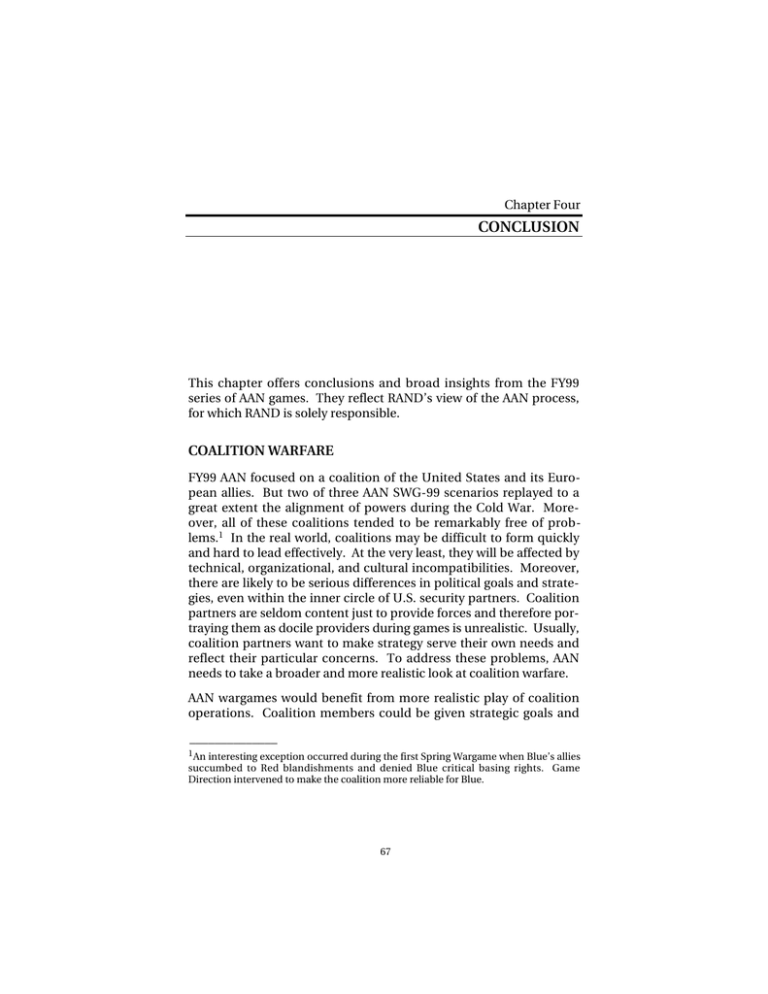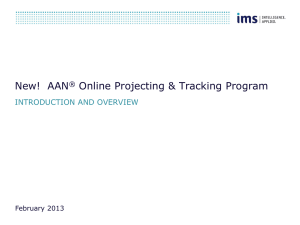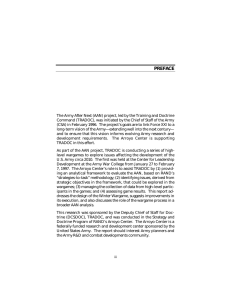CONCLUSION
advertisement

Chapter Four CONCLUSION This chapter offers conclusions and broad insights from the FY99 series of AAN games. They reflect RAND’s view of the AAN process, for which RAND is solely responsible. COALITION WARFARE FY99 AAN focused on a coalition of the United States and its European allies. But two of three AAN SWG-99 scenarios replayed to a great extent the alignment of powers during the Cold War. Moreover, all of these coalitions tended to be remarkably free of problems.1 In the real world, coalitions may be difficult to form quickly and hard to lead effectively. At the very least, they will be affected by technical, organizational, and cultural incompatibilities. Moreover, there are likely to be serious differences in political goals and strategies, even within the inner circle of U.S. security partners. Coalition partners are seldom content just to provide forces and therefore portraying them as docile providers during games is unrealistic. Usually, coalition partners want to make strategy serve their own needs and reflect their particular concerns. To address these problems, AAN needs to take a broader and more realistic look at coalition warfare. AAN wargames would benefit from more realistic play of coalition operations. Coalition members could be given strategic goals and ______________ 1 An interesting exception occurred during the first Spring Wargame when Blue’s allies succumbed to Red blandishments and denied Blue critical basing rights. Game Direction intervened to make the coalition more reliable for Blue. 67 68 The Future of Warfare: Issues from the 1999 Army After Next Study Cycle hence campaign objectives that differ substantially from U.S. views. They could set conditions for their participation in the coalition. They could try to constrain rules of engagement and place limits on certain kinds of military operations. Or they might behave more aggressively than the United States would prefer. Requiring more realism would help generate more insights into the coalitions, especially the Army’s role in helping build and maintain them. In addition, the role of Objective Forces within coalitions needs exploration. Leap-ahead technologies would give Objective Forces capabilities unmatched even by the closest U.S. allies and also create technical incompatibilities. One solution would be a division of labor with Objective Forces executing stand-alone missions, e.g., deep penetration and exploitation. But divisions of labor tend to strain coalitions, especially when some powers feel they are running disproportionate risks, and they may not attain optimal synergisms for unlike forces. Despite gross disparity in capabilities, the future Objective Forces might be able to operate closely with coalition forces, magnifying their combat power. If so, Objective Forces should prepare in peacetime through forward deployment and combined exercises. HYBRID U.S. ARMY FORCES From the inception of the AAN project, the Army has assumed that its forces in 2020–2025 will be hybrid, i.e., a mix of Army XXI units and more modern forces, represented conceptually by Battle Forces. The past three AAN games generated insights into how these disparate forces might operate together. 2 During the first two AAN games, AAN forces were rushed into theater, to be followed by Army XXI units. Battle Forces arrived earlier and maneuvered more rapidly, including operational maneuver by air. They attempted to destroy or disrupt opposing forces before they could respond effectively. Army XXI forces arrived later and maneuvered more slowly on land. They consolidated the gains made ______________ 2 For many years, the Objective Force will also be hybrid. Although the Transformation Plan calls for an Objective Force that encompasses the entire Army, it is likely that current capabilities will still exist in the Army of 2020. Conclusion 69 by Battle Forces and accomplished essential missions, especially seizure of key urban areas, that exceeded the capabilities of Battle Forces. During AAN SWG-99, Battle Forces operated in conjunction with powerful U.S. Air Force, Navy, and Marine Corps elements and highly capable coalition forces, including mechanized and airmobile forces. In contrast with earlier iterations, they had less opportunity to operate in conjunction with Army XXI units, particularly in Case B, which was the more modernized U.S. force. Instead, Army XXI forces provided specialized functions such as air defense and logistics support. Coalition ground forces had the roles played by Army XXI forces during previous iterations, especially in Case B. To more fully understand the implications of a hybrid force, future games should have scenarios that promote common operations rather than divisions of labor. SPECTRUM OF BATTLE FORCES During its first two years, the AAN project focused attention on ground forces that employed some form of airlift in theater. Indeed, such airlift was considered necessary to attain sufficiently rapid maneuver: Some form of theater/tactical airlifter—whether that be a vertical takeoff and landing (VTOL), super-short takeoff and landing (SSTOL) or Joint Transport Rotor (JTR)—must be developed and fielded in considerable numbers to obtain this breakthrough in ground force speed.3 But during the third year, the AAN project examined Battle Forces, which used other operational concepts. At one end of the spectrum, the LABF with 2.5-ton vehicles could airdrop into a theater of operations, while at the other end, the MABF with 26-ton vehicles went by sealift. Appendix C provides a brief summary of the various types of Battle Forces that were examined in AAN SWG-99. ______________ 3 Knowledge and Speed, 1998, p. 10. 70 The Future of Warfare: Issues from the 1999 Army After Next Study Cycle Previous iterations of the AAN cycle featured just one type of Battle Force based on an air-mechanized concept. This concept offered advantages of global self-deployment, vertical maneuver, and precision fires. But it also had severe limitations: inability to fight in urban terrain, inability to hold terrain, and vulnerability to opposing air defense. 4 In view of these limitations, there was a need for more force types based on other concepts. AAN SWG-99 answered this need by introducing four new types of Battle Forces (five if AMBF and MABF are considered different types). The heaviest of these (AMBF/MABF) had 26-ton vehicles, while the LABF was armed with 2.5-ton systems. This move toward multiple types of notional Battle Forces provides more options for exploration. In AAN SWG-99, the AMBF had organic airlift, while the MABF deployed primarily on fast ships. As the Army Transformation process continues, TRADOC should consider a wide range of alternative forces and operational concepts. From the perspective of game preparation, this will require that new force designs be finalized in time for tactical and logistics planners to assess the capabilities of the hypothetical organizations. Now that the Army is clarifying its Transformation Plan, future games will examine various issues associated with the envisioned Interim and Objective Forces (whose ultimate character is undetermined at the time of this writing), and contribute to the understanding and evolution of the organizations associated with the goals of Transformation. Ultralight Battle Forces There is no a priori reason to assume that a future force would employ land vehicles of any particular size and weight, or any land vehicles at all. Indeed, during the second iteration of the AAN cycle, the light Battle Force practically dispensed with ground vehicles. A force of this sort might operate in ways comparable to today’s special operations forces, such as Rangers and Army Special Forces, when employed in direct action missions with strong air support. Once ______________ 4 See Walter L. Perry, Bruce R. Pirnie, and John V. Gordon, Issues Raised During the Army After Next Spring Wargame, Santa Monica, CA: RAND, MR-1023-A, 1999, pp. 39– 42. Conclusion 71 inserted, it might maneuver on foot or by small, ultralight ground and air vehicles. There are obvious risks and limitations to this concept, but perhaps not greater than those already incurred by vehicles in the 2.5-ton class, as employed by the LABF during AAN SWG-99. Air-Mechanized Battle Forces During AAN SWG-99, the AABF (8-ton combat vehicles transported by JTR) embodied the air-mechanized concept, but at a lower degree of effectiveness than the previous air-mechanized force (15-ton vehicles transported by specially developed tilt-rotor aircraft). In the end, an air-mechanized concept might be infeasible, unaffordable, or both, but until such a determination it should have stayed in the running. To be fully understood, an air-mechanized force should be considered as a candidate for the Objective Force. Heavier Battle Forces The Future Combat Vehicle, as played in AAN SWG-99, weighed no more than 26 tons on the assumption that a follow-on aircraft to the C-130 would be able to lift 30 tons. But such an aircraft may not be built, or may not be available in large numbers in the 2030 timeframe. Moreover, building a 26-ton vehicle with sufficient survivability in close combat would be difficult, even assuming great improvements in active protection. Therefore, there is merit in examining heavier Battle Forces that cannot conduct operational maneuver by air as well as lighter Battle Forces that can perform such maneuver. Since the announcement of the Army Transformation Plan in the fall of 1999, the focus of future Army research will be on Interim and Objective Force organizations and concepts. Many of the issues that appeared in AAN SWG-99 merit examination, even though since the end of AAN SWG-99, the Army is no longer actively considering Battle Forces. Issues about deployment speed, feasibility of strategic preclusion, coalition operations, and insights on the strengths and weaknesses of new organizations in relation to Army XXI forces will all require considerable research, even though the specific organizations included in AAN SWG-99 have been overtaken by the Transformation Plan concepts.


